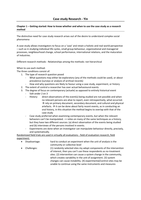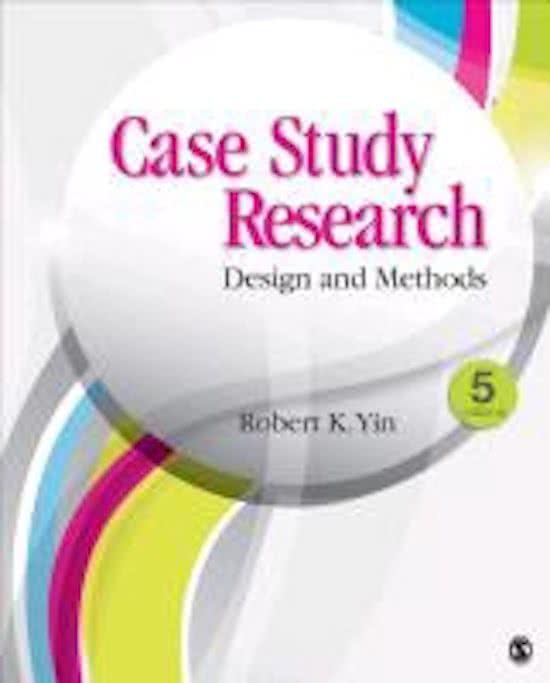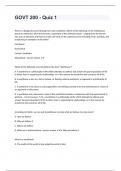Case study Research - Yin
Chapter 1 – Getting started: How to know whether and when to use the case study as a research
method
The distinctive need for case study research arises out of the desire to understand complex social
phenomena
A case-study allows investigators to focus on a ‘case’ and retain a holistic and real-world perspective
– such as in studying individual life cycles, small group behaviour, organizational and managerial
processes, neighbourhood change, school performance, international relations, and the maturation
of industries.
Different research methods - Relationships among the methods: not hierarchical
When to use each method:
The three conditions consist of:
1. The type of research question posed
- What questions may either be exploratory (any of the methods could be used), or about
prevalence (surveys or analysis of archival records)
- How and why questions are likely to favour using a case study, experiment, or history
2. The extent of control a researcher has over actual behavioural events
3. The degree of focus on contemporary (actuele) as opposed to entirely historical event
- Valt onder 2 en 3
- History: direct observations of the event(s) being studied are not possible and when
no relevant persons are alive to report, even retrospectively, what occurred.
rely on primary document, secondary document, and cultural and physical
artefacts. it can be done about fairly recent events, as in conducting an
oral history, in this situation the method begins to overlap with that of the
case study
- Case study preferred when examining contemporary events, but when the relevant
behaviors can’t be manipulated. –> relies on many of the same techniques as a history,
but they have two different sources: (a) direct observation of the events being studied
and (b) interviews of the persons involved in events.
- Experiments are done when an investigator can manipulate behaviour directly, precisely,
and systematically.
Randomized field trials are used in virtually all evaluations - field of evaluation research, field
experiment:
Disadvantage: hard to conduct an experiment when the unit of analysis is the
community or collective level
Challenges: (1) randomly selected sites my adopt components of the intervention
of interest, then you can’t use these respondents as no-treatment
sites. (2) intervention can cause a system change in the community,
which creates variability in the unit of assignment. (3) system
changes can cause instability. (4) experimental/control sites may be
unable to continue using the same instruments and measures






